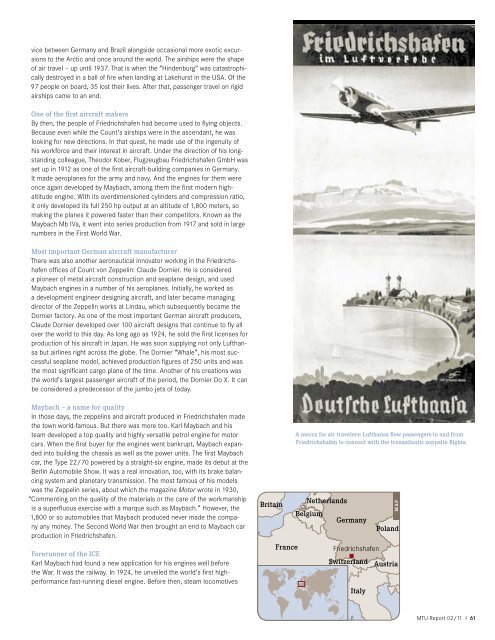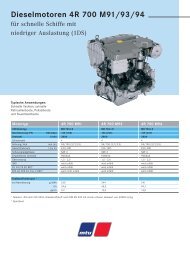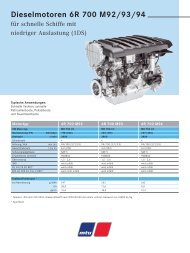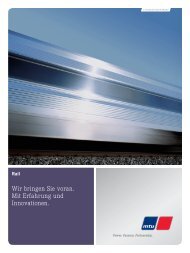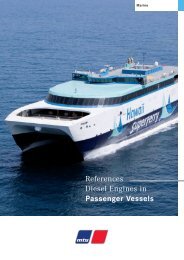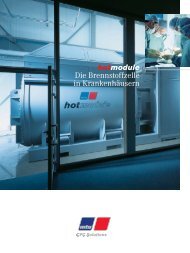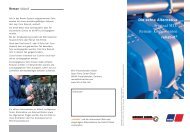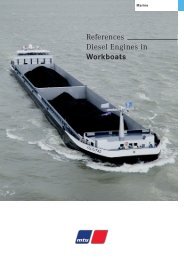You also want an ePaper? Increase the reach of your titles
YUMPU automatically turns print PDFs into web optimized ePapers that Google loves.
vice between Germany and Brazil alongside occasional more exotic excursions<br />
to the Arctic and once around the world. The airships were the shape<br />
<strong>of</strong> air travel – up until 1937. That is when the “Hindenburg” was catastrophically<br />
destroyed in a ball <strong>of</strong> fire when landing at Lakehurst in the USA. Of the<br />
97 people on board, 35 lost their lives. After that, passenger travel on rigid<br />
airships came to an end.<br />
One <strong>of</strong> the first aircraft makers<br />
By then, the people <strong>of</strong> Friedrichshafen had become used to flying objects.<br />
Because even while the Count’s airships were in the ascendant, he was<br />
looking for new directions. In that quest, he made use <strong>of</strong> the ingenuity <strong>of</strong><br />
his workforce and their interest in aircraft. Under the direction <strong>of</strong> his longstanding<br />
colleague, Theodor Kober, Flugzeugbau Friedrichshafen GmbH was<br />
set up in 1912 as one <strong>of</strong> the first aircraft-building companies in Germany.<br />
It made aeroplanes for the army and navy. And the engines for them were<br />
once again developed by Maybach, among them the first modern high-<br />
altitude engine. With its overdimensioned cylinders and compression ratio,<br />
it only developed its full 250 hp output at an altitude <strong>of</strong> 1,800 meters, so<br />
making the planes it powered faster than their competitors. Known as the<br />
Maybach Mb IVa, it went into series production from 1917 and sold in large<br />
numbers in the First World War.<br />
Most important German aircraft manufacturer<br />
There was also another aeronautical innovator working in the Friedrichshafen<br />
<strong>of</strong>fices <strong>of</strong> Count von Zeppelin: Claude Dornier. He is considered<br />
a pioneer <strong>of</strong> metal aircraft construction and seaplane design, and used<br />
Maybach engines in a number <strong>of</strong> his aeroplanes. Initially, he worked as<br />
a development engineer designing aircraft, and later became managing<br />
director <strong>of</strong> the Zeppelin works at Lindau, which subsequently became the<br />
Dornier factory. As one <strong>of</strong> the most important German aircraft producers,<br />
Claude Dornier developed over 100 aircraft designs that continue to fly all<br />
over the world to this day. As long ago as 1924, he sold the first licenses for<br />
production <strong>of</strong> his aircraft in Japan. He was soon supplying not only Lufthansa<br />
but airlines right across the globe. The Dornier “Whale”, his most successful<br />
seaplane model, achieved production figures <strong>of</strong> 250 units and was<br />
the most significant cargo plane <strong>of</strong> the time. Another <strong>of</strong> his creations was<br />
the world’s largest passenger aircraft <strong>of</strong> the period, the Dornier Do X. It can<br />
be considered a predecessor <strong>of</strong> the jumbo jets <strong>of</strong> today.<br />
Maybach – a name for quality<br />
In those days, the zeppelins and aircraft produced in Friedrichshafen made<br />
the town world-famous. But there was more too. Karl Maybach and his<br />
team developed a top quality and highly versatile petrol engine for motor<br />
cars. When the first buyer for the engines went bankrupt, Maybach expanded<br />
into building the chassis as well as the power units. The first Maybach<br />
car, the Type 22/70 powered by a straight-six engine, made its debut at the<br />
Berlin Automobile Show. It was a real innovation, too, with its brake balancing<br />
system and planetary transmission. The most famous <strong>of</strong> his models<br />
was the Zeppelin series, about which the magazine Motor wrote in 1930,<br />
“Commenting on the quality <strong>of</strong> the materials or the care <strong>of</strong> the workmanship<br />
is a superfluous exercise with a marque such as Maybach.” However, the<br />
1,800 or so automobiles that Maybach produced never made the company<br />
any money. The Second World War then brought an end to Maybach car<br />
production in Friedrichshafen.<br />
Forerunner <strong>of</strong> the ICE<br />
Karl Maybach had found a new application for his engines well before<br />
the War. It was the railway. In 1924, he unveiled the world’s first high-<br />
performance fast-running diesel engine. Before then, steam locomotives<br />
Britain<br />
France<br />
A mecca for air travelers: Lufthansa flew passengers to and from<br />
Friedrichshafen to connect with the transatlantic zeppelin flights.<br />
Netherlands<br />
Belgium<br />
Germany<br />
Friedrichshafen<br />
MAP<br />
<strong>MTU</strong> Brown <strong>MTU</strong> Brown<br />
0-17-28-62 80% der Farbe 60% 40% 20%<br />
CMYK CMYK CMYK CMYK CMYK<br />
Switzerland Austria<br />
Italy<br />
Poland<br />
<strong>MTU</strong> Blue <strong>MTU</strong> Blue<br />
60% 40% 20%<br />
50-25-0-10 80% der Farbe<br />
CMYK CMYK CMYK<br />
CMYK CMYK<br />
<strong>MTU</strong> Report 02/11 I 61


